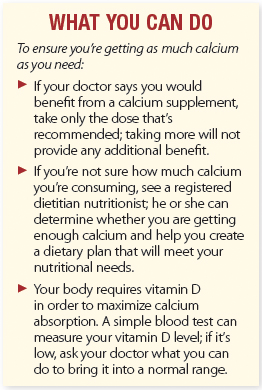Optimize Your Calcium Absorption for Stronger Bones
To keep your bones strong and reduce your risk of osteoporosis and fractures, it’s essential to consume an adequate amount of calcium. However, it’s also important to consider factors that can inhibit calcium absorption or increase calcium excretion to make sure the calcium you need is actually getting to your bones.
As you get older, your body’s ability to absorb calcium declines. Women who are postmenopausal absorb less calcium due to decreased estrogen levels. Other factors that may affect how much calcium is absorbed include medications, health conditions, and what you eat and drink.
Calcium and Medications
“Many people take over-the-counter or prescribed proton pump inhibitors, such as omeprazole (Prilosec), lansoprazole (Prevacid), and esomeprazole (Nexium), for the treatment of heartburn and acid reflux. These medications reduce the amount of acid produced in the stomach, which can decrease calcium absorption,” says Vivian Sobel, MD, an endocrinologist at Weill Cornell Medicine.

Taking oral corticosteroid medications, such as prednisone, prednisolone, hydrocortisone, or methylprednisolone, for longer than six weeks can interfere with calcium absorption. If you take corticosteroids via an inhaler or injection, or you take them for a brief period of time, your risk of decreased calcium absorption is much lower.
Loop diuretics, medications used to treat high blood pressure, also may affect calcium absorption. They include furosemide (Lasix), bumetanide (Bumex), and torsemide (Demadex).
If you take a calcium supplement, avoid taking any of these medications at the same time as the supplement; take them at least four hours apart.
Digestive Disorders
Any disease or illness that affects the function of your digestive system, especially your small and large intestines, may impact how much calcium you’re getting. A condition that limits the absorption of nutrients is referred to as a “malabsorption syndrome.”
“Many malabsorption syndromes, including inflammatory bowel disease, lactose intolerance, and celiac disease, impair the ability of the intestinal tract to absorb calcium,” explains Dr. Sobel.
She adds that vitamin D deficiency also leads to calcium malabsorption, as does a deficiency in magnesium.
Dietary Factors
Several foods and beverages can affect the amount of calcium that is absorbed or eliminated by the body. For example, a substance called oxalic acid binds to calcium and can inhibit its absorption. Foods high in oxalic acid include spinach, Swiss chard, kale, beet and collard greens, rhubarb, and beans. However, these foods are excellent sources of many nutrients, so don’t eliminate them from your diet; just make sure you’re not eating large amounts and you’re getting plenty of other vegetables as well.
Consuming excessive sodium, protein, and/or caffeine may increase the amount of calcium that is eliminated from your body, although moderate intake of these items does not cause a calcium deficiency in a healthy person.
Drinking alcohol can reduce calcium absorption. It’s unknown how much alcohol it takes to alter calcium levels. The best strategy is to follow general recommendations for alcohol intake, which is no more than one alcoholic drink a day for women.
Is Your Calcium Level Low?
Your body has a fairly complex system for regulating calcium, so it’s not always easy to detect a calcium deficiency. If you don’t consume or absorb enough calcium, your body will remove calcium from your bones in order to compensate.
Dr. Sobel says significant calcium malabsorption can be detected by measuring calcium levels, and more subtle calcium malabsorption can be detected by measuring parathyroid hormone levels.
Hormonal changes that occur during menopause put women at increased risk of osteoporosis and fractures, so it’s smart to discuss your calcium status with your doctor.
The post Optimize Your Calcium Absorption for Stronger Bones appeared first on University Health News.
Read Original Article: Optimize Your Calcium Absorption for Stronger Bones »

